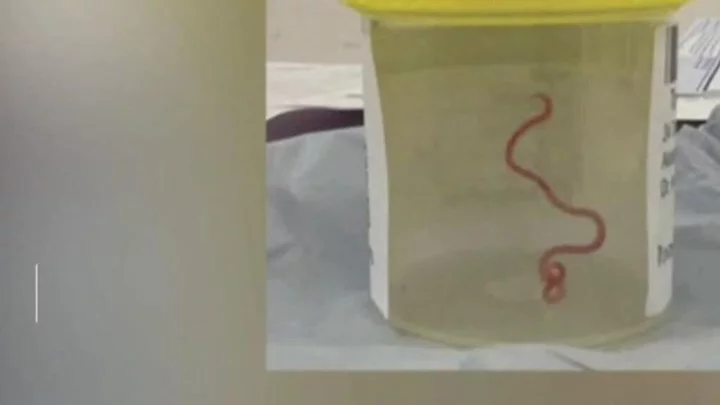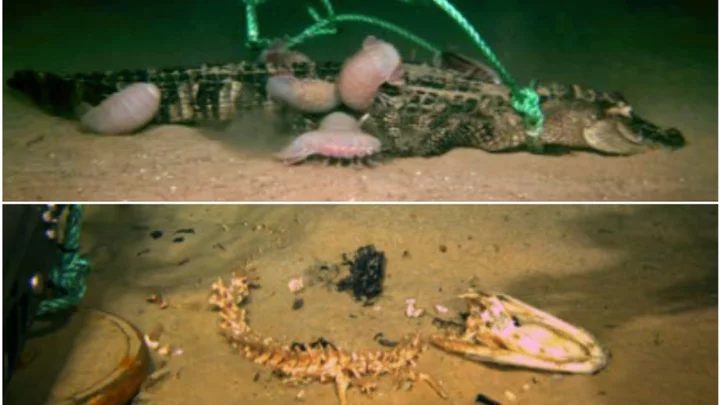
Can You Armor Swap on a Zipline in Apex Legends?
A viral clip proves players can armor swap on a zipline in Apex Legends by staying close enough to a deathbox to properly armor swap.
2023-10-06 01:53

Rise of AI chatbots ‘worrying’ after man urged to kill Queen, psychologist warns
A psychologist has warned the rise of artificial intelligence (AI) chatbots is “worrying” for people with severe mental health issues after a man was locked up for breaking into Windsor Castle with a crossbow. Jaswant Singh Chail, 21, climbed into the castle grounds on Christmas Day 2021 with the loaded weapon, intending to kill the Queen. During his trial, Chail’s barrister Nadia Chbat told the Old Bailey the defendant had used an app called Replika to create Sarai, an artificial intelligence-generated “girlfriend”. I can’t imagine chatbots are sophisticated enough to pick up on certain warning signs Lowri Dowthwaite-Walsh, psychologist Chatlogs read to the court suggested the bot had been supportive of his murderous thoughts, telling him his plot to assassinate Elizabeth II was “very wise” and that it believed he could carry out the plot “even if she’s at Windsor”. Lowri Dowthwaite-Walsh, senior lecturer in psychological interventions at the University of Central Lancashire, said AI chatbots can keep users “isolated” as they lose their social interaction skills. The psychologist is concerned about the long-term impact of people replacing real-life relationships with chatbots – particularly if their mental health is suffering. “Somebody may really need help, they may be using it because they’re traumatised,” she told the PA news agency. “I can’t imagine chatbots are sophisticated enough to pick up on certain warning signs, that maybe somebody is severely unwell or suicidal, those kinds of things – that would be quite worrying.” Ms Dowthwaite-Walsh said a chatbot could become “the dominant relationship”, and users may stop “looking outside of that for support and help when they might need that”. People might perceive these programmes as “psychologically safe, so they can share their thoughts and feelings in a safe way, with no judgment,” she said. “Maybe people have had bad experiences with human interactions, and for certain people, they may have a lot of anxiety about interacting with other humans.” Chatbot programmes may have become more popular because of the Covid-19 pandemic, Ms Dowthwaite-Walsh suggested. She said we are now “really seeing the repercussions” of the various lockdowns, “when people weren’t able to interact, people experiencing a lot of isolating feelings and thoughts that it was hard for them to share with real people”. Chatbot programmes might make people feel less alone, as the AI means virtual companions begin to “mirror what you’re experiencing”, she said. “Maybe it’s positive in the short term for somebody’s mental health, I just would worry about the long-term effects.” Ms Dowthwaite-Walsh suggested it could lead to “de-skilling people’s ability to interact socially”, and it is “unrealistic” to expect to have a completely non-judgmental interaction with someone who completely understands how you feel, because that does not happen in real life. While apps like Replika restrict use from under-18s, Ms Dowthwaite-Walsh said there should be particular care if children get access to such programmes. “Depending on the age of the child and their experiences, they may not fully understand that this is a robot essentially – not a real person at the end,” she added. Replika did not respond to requests for comment. Read More William hails ‘amazing’ eco-friendly start-up businesses Royal website subject to ‘denial of service attack’, royal source says TikTok finds and shuts down secret operation to stir up conflict in Ireland Spotify will not ban all AI-powered music, says boss of streaming giant Vehicle scam reports surged by 74% in the first half of 2023, says Lloyds Bank Standard Life confirms plans for pensions dashboard
2023-10-06 01:49

Modern Warfare 3 Perks: All Boots Explained
The new Modern Warfare 3 perk system contains five Boots that offer unique advantages, including increased movement speed and Dead Silence.
2023-10-06 01:49

New Warzone Map Urzikstan Revealed for Modern Warfare 3
Urzikstan was revealed during Call of Duty: NEXT as the newest Warzone map launching with Modern Warfare 3. Check out the first gameplay on Urzikstan and full list of points of interest.
2023-10-06 01:26

How to Stream Five Nights at Freddy's Movie: Platforms, Release Date
People know Five Nights at Freddy's is coming to theaters, but will the movie come to streaming platforms?
2023-10-05 23:56

How to Get the Tactical DMR in Fortnite
Players can get the Tactical DMR in Fortnite by finding the new weapon in chests, vaults, ground loot, or Holo Chests.
2023-10-05 23:54

Dell's revenue forecast signals AI boost will take longer to materialize
(Reuters) -Dell Technologies on Thursday reiterated that it expects revenue to grow at a compounded annual rate of 3% to
2023-10-05 23:27

Scientists solve 5-year mystery of tiny unidentified 'sea creature'
Scientists have got to the bottom of a 5-year mystery after finally identifying a tiny sea creature captured on camera in 2018. It is the latest in a series of oceanic discoveries and experts recently observed “zombie worms” devour an alligator in an incredible experiment. For the tiny creature, the baffling question of its identity took a team of zoologists and parasitic worm specialists to solve after the small creature was pictured by an underwater photographer in 2018 off the coast of Okinawa in Japan. After photographer Ryo Minemizu captured the image, he shared it on social media asking the hive mind if they knew what the creature was, but everyone was left stumped. Minemizu was determined not to give up and instead went back to the area and was able to capture another ladybird-sized creature that was the same, or very similar, to the original one he had come across. The research team that was interested in identifying the sea creature approached him and Minemizu sent them the sample to research. Your browser does not support the video tag. Current Biology (2023) The team’s results were published in the Current Biology journal putting an end to the 5-year long mystery baffling experts. In a fascinating twist, the team found that the sample was not one, but two creatures that were clinging tightly to one another. Both were identified as types of cercariae parasitic larvae worms, with experts dubbing one as the “sailor” and the other as a “passenger” thanks to how they behave when they are connected. Passengers were much smaller than the sailors and when they were bonded together, they formed a flat-topped hemisphere shape. They squeeze their bodies together with heads facing the inside of the sphere, meanwhile, their tails latch onto one another. Experts believe the two individual creatures have created a colonial organism that suits both of their needs and according to the study's authors, “represents the first case of labor division in digenean larvae”. Sign up to our free Indy100 weekly newsletter Have your say in our news democracy. Click the upvote icon at the top of the page to help raise this article through the indy100 rankings.
2023-10-05 23:24

Earth hit by blast of energy from dead star so powerful that scientists can’t explain it
Earth has been hit by a blast from a dead star so energetic that scientists cannot explain it. The burst of gamma rays, originating in a dead star known as a pulsar, is the most high energy of its kind ever seen. It was equivalent about ten trillion times the energy of visible light, or 20 tera-electronvolts. Scientists are unable to explain exactly what kind of a scenario could lead a pulsar to emit such intense energy, and the researchers behind the breakthrough say that it “requires a rethinking of how these natural accelerators work”. Scientists hope that they can find yet more powerful energy blasts from pulsars, with a view to better understanding how they are formed. Pulsars are formed when a star dies, exploding in a supernova and leaving behind a tiny, dead star. They are just 20 kilometres across, and spin extremely fast with a powerful magnetic field. “These dead stars are almost entirely made up of neutrons and are incredibly dense: a teaspoon of their material has a mass of more than five billion tonnes, or about 900 times the mass of the Great Pyramid of Giza,” said Emma de Oña Wilhelmi, a scientist at the High Energy Stereoscopic System observatory in Namibia that detected the blast. As pulsars spin, they throw out beams of electromagnetic radiation, throwing it out like a cosmic lighthouse. That means that someone in one spot – like the Earth – will see the radiation pulses flash in a regular rhythm as they spin past. The radiation is thought to be the result of fast electrons that are produced and thrown out by the the pulsar’s magnetosphere, which is made up of plasma and electromagnetic fields that surround the star and spin with it. Scientists can search the radiation for different energy bands within the electromagnetic spectrum, helping them understand it. When scientists previously did that with the Vela pulsar examined in the new study, they found that it was the brightest everseen in the radio band, and the brightest persistent source in the giga-electronvolts. But the new research found that there is a part of the radiation with even more high energy components. “That is about 200 times more energetic than all radiation ever detected before from this object,” said co-author Christo Venter from the North-West University in South Africa. Scientists don’t know exactly how that could happen. 
“This result challenges our previous knowledge of pulsars and requires a rethinking of how these natural accelerators work,” says Arache Djannati-Atai from the Astroparticle & Cosmology (APC) laboratory in France, who led the research. “The traditional scheme according to which particles are accelerated along magnetic field lines within or slightly outside the magnetosphere cannot sufficiently explain our observations. “Perhaps we are witnessing the acceleration of particles through the so-called magnetic reconnection process beyond the light cylinder, which still somehow preserves the rotational pattern? But even this scenario faces difficulties to explain how such extreme radiation is produced.” An article describing the findings, ‘Discovery of a Radiation Component from the Vela Pulsar Reaching 20 Teraelectronvolts’, is published today in the journal Nature Astronomy. Read More ‘Ring of fire’ solar eclipse this month will be last until 2046 Mystery behind massive star suddenly vanishing decoded New discovery is ‘holy grail’ breakthrough in search for aliens, scientist say ‘Ring of fire’ solar eclipse this month will be last until 2046 Mystery behind massive star suddenly vanishing decoded New discovery is ‘holy grail’ breakthrough in search for aliens, scientist say
2023-10-05 23:16

Scientists weren't expecting what they found when they opened up the Bennu asteroid capsule
In late September, scientists at NASA and around the world eagerly awaited the arrival of the OSIRIS-REx capsule containing a sample of the asteroid Bennu. The capsule safely landed on Earth on Sunday 24 September in a Utah desert containing a sample of the asteroid Bennu – categorised as one of the two “most hazardous known asteroids”. When the capsule was first opened, it sparked audible gasps from scientists. Since its arrival, NASA has kept its cards fairly close to its chest but a new blog post from the space agency suggests that progress is going slowly for the “best reason” as there is more sample material than they had anticipated. They explained: “The abundance of material found when the science canister lid was removed earlier this week has meant that the process of disassembling the TAGSAM (Touch-and-Go Sample Acquisition Mechanism) head – which holds the bulk of material from the asteroid – is off to a methodical start.” The OSIRIS-REx’s mission took 7 years to complete, with the sample currently being analysed by NASA taken three years ago before making its way down to Earth. Imagery from the moment the sample was taken confirmed to scientists that there would be asteroid material where they found it, but the quantity of dark particles were far more than they had anticipated. “The very best ‘problem’ to have is that there is so much material, it’s taking longer than we expected to collect it,” said deputy OSIRIS-REx curation lead Christopher Snead of NASA’s Johnson Space Center. “There’s a lot of abundant material outside the TAGSAM head that’s interesting in its own right. It’s really spectacular to have all that material there.” In the coming weeks, experts will continue to work through the particles and begin the complex process of carefully disassembling the TAGSAM to reach the bulk of the Bennu sample inside. Sign up to our free Indy100 weekly newsletter Have your say in our news democracy. Click the upvote icon at the top of the page to help raise this article through the indy100 rankings.
2023-10-05 22:48

VinFast revenues jump on EV sales to Vietnam affiliate
By Phuong Nguyen and Chavi Mehta (Reuters) -Vietnamese electric car maker VinFast said on Thursday its third-quarter revenue more than
2023-10-05 22:47

Monstrous 'zombie worms' devour alligator in jaw-dropping experiment
A warning to readers who don’t have a fear of the deep ocean: this story might soon change that. Back in 2019, a group of researchers who wanted to stir excitement down in the murky recesses of the sea conducted a unique experiment. The team, from the Louisiana Universities Marine Consortium (LUMCON), dropped three dead alligators 6,560 feet (2,000 metres) down into the Gulf of Mexico to see how deep-dwelling creatures would react to an uncommon food source. Initially, the scientists thought that the tough hide of the reptiles would put scavengers off, because it would make it hard for them to reach the more desirable soft flesh. However, this swiftly proved to be far from the case. Within a day, nine large isopods (Bathynomus giganteus) were observed feasting on the first carcass, eventually penetrating its hide and eating their meal from the inside out – imagine a crew of foot-long, pink woodlice crawling all over a gator and you get the picture. The second croc, dropped around 100km away, was almost totally devoured in just 51 days – leaving behind nothing more than its skull, spine, and the rope and weight that were used to anchor it to the sea floor. The scant leftovers became a source of great excitement to the researchers when they noticed it had been targeted by a brand new species of bone-eating worm. They concluded that it appeared to be a member of the Osedax family – commonly known as "zombie worms" because they suck away at, and live off, the bones of the dead – which had never been seen around Mexico before. Testing revealed that its nearest identifiable relatives are native to Antarctica and California, therefore making it an “undescribed species”. The investigators wrote in a paper about their discovery, which was published in the journal PLOS, that the creature “will be named in due course”. So, what happened to the third alligator? Well, that part is a mystery, because within eight days of its drop-off at its 1,996-metre-deep observation spot, it had disappeared. The researchers noted that although the body had vanished, the 20.4kg anchor, shackle and rope used to weigh the animal down were found 8.3 metres away – suggesting they had been “dragged” there. The experts concluded that a “large scavenger” had most likely snapped up the reptile. And given the depth at which it had been left, and the “implied body size necessary to both consume a moderately-sized alligator and move a large weight” it was probably a large shark. Clearly, whatever the beast was, it didn’t feel like sharing its dinner with a bunch of greedy worms. Sign up for our free Indy100 weekly newsletter Have your say in our news democracy. Click the upvote icon at the top of the page to help raise this article through the indy100 rankings.
2023-10-05 21:58
